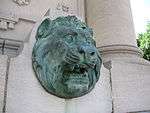Westland Gate
Westland Gate (also known as the Johnson Gates) is a pair of fountains that borders the Back Bay Fens at the end of Westland Avenue in Boston.
History

Westland Gate was designed by Guy Lowell, architect of the Boston's Museum of Fine Arts, and was built in 1902 and erected in 1905. The decorative bronze was produced by the Hecla Iron Works. The fountains were originally named the Johnson Memorial Fountain after a wealthy Bostonian, Jesse Johnson, whose widow, Ellen Cheney Johnson, donated money to erect them. The fountains consist of two large pillars caped with bronze frieze panels made of granite and Tennessee marble flanking the street with four bronze lions heads near their bases that originally spouted water.[1]
From the gates' plaque (installed in 1991):
"This entrance to the Fens, originally known as the Johnson Memorial Fountain, was donated to the City of Boston and erected in 1905 through a generous bequest from Mrs. Ellen Cheney Johnson in memory of her husband Jesse. A grant from Boston's Edward Ingersoll Browne Trust Fund and monies from the gates' maintenance endowment made possible a 1980 restoration. The Ellen C. Johnson Trust Fund provided for subsequent renovations in 1990. The gates are under the management of the City of Boston Parks and Recreation Department."
Restoration Efforts
The fountains were first restored in 1980.[2] It appears that the 1980 restoration involved either sandblasting or honing to address inconsistencies in the stone, as well as application of a protective treatment (to resist graffiti) using Browne Fund money.[3] The gates were rededicated in a ceremony that followed this restoration in August 1980. The 1990 restoration involved cleaning of the marble, repointing and repair of cracks in the stone, application of protective treatment, and cleaning and repair of the metal components (decorative frieze, lion heads, and commemorative plaque). A new lighting system was proposed for the gates at this time, but seems never to have been installed. On May 4, 2008 a spokesperson for the Boston Parks Department stated that the "fountains are on a list of projects to be repaired".[4] However, over a year later, the fountains still remain in poor condition and are non-functional.
A new restoration effort began in October 2013 to repair stonework and make the fountains operable again. In 2013 the bronze elements were cleaned and treated with wax sealant. In 2014 Preservation Massachusetts designated the Johnson Memorial Gates as one of the Massachusetts Most Endangered Historic Resources.[5] In 2015 funding from the Browne Fund restored the two horse troughs and provided weather tight covers on Hemenway Street. For fiscal year 2017 the city of Boston has approved $820,000 for Johnson Memorial Gates monument conservation, accessibility upgrades, and landscape rehabilitation.
References
- ↑ "Johnson Memorial Fountain and Gate, (sculpture)". Save Outdoor Sculpture, Massachusetts survey. 1997. Retrieved December 6, 2011.
- ↑ Marcus, Jon. The Complete Illustrated Guidebook to Boston's Public Parks and Gardens, (Silver Lining Books, NY, 2002),pg 54.
- ↑ Boston Globe. Boston, Mass.: Dec 31, 1980. pg. 1
- ↑ Christina Pazzanese (May 4, 2008). "Hope Springs Eternal for Restoring Fountains to Youth". The Boston Globe.
- ↑ http://preservationmass.org/programs/most-endangered-resources/2014-most-endangered-resource-list/1-johnson-memorial-gates/
 Detail of cat head on Westland Gate
Detail of cat head on Westland Gate
Coordinates: 42°20′38″N 71°05′24″W / 42.3440°N 71.0900°W
